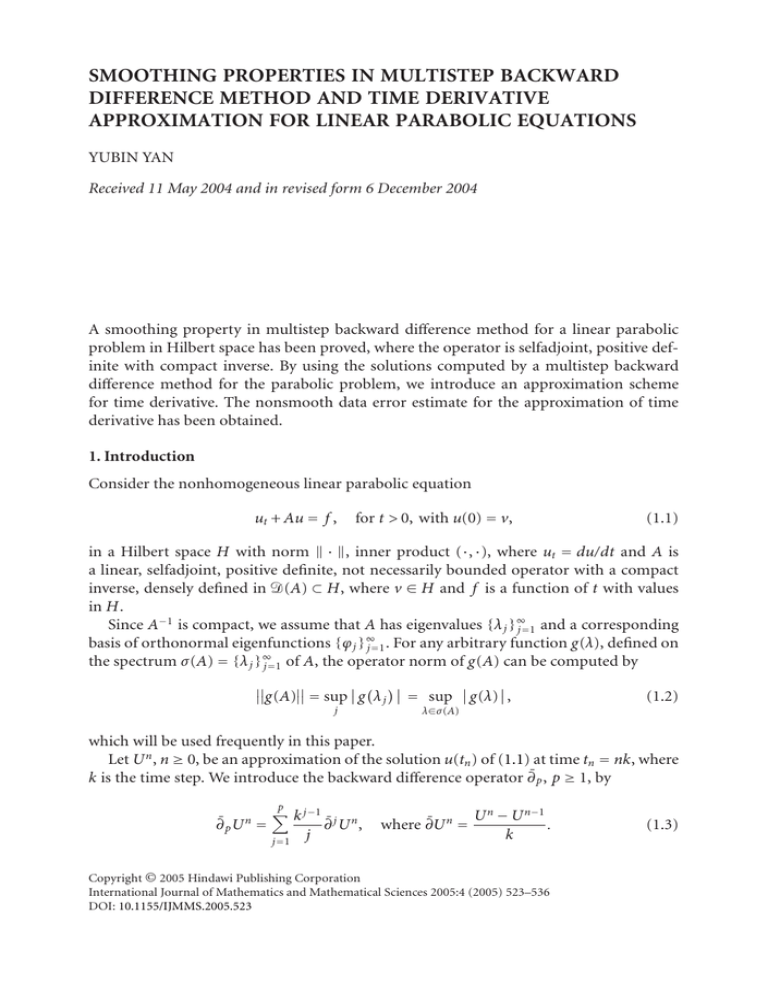SMOOTHING PROPERTIES IN MULTISTEP BACKWARD DIFFERENCE METHOD AND TIME DERIVATIVE
advertisement

SMOOTHING PROPERTIES IN MULTISTEP BACKWARD
DIFFERENCE METHOD AND TIME DERIVATIVE
APPROXIMATION FOR LINEAR PARABOLIC EQUATIONS
YUBIN YAN
Received 11 May 2004 and in revised form 6 December 2004
A smoothing property in multistep backward difference method for a linear parabolic
problem in Hilbert space has been proved, where the operator is selfadjoint, positive definite with compact inverse. By using the solutions computed by a multistep backward
difference method for the parabolic problem, we introduce an approximation scheme
for time derivative. The nonsmooth data error estimate for the approximation of time
derivative has been obtained.
1. Introduction
Consider the nonhomogeneous linear parabolic equation
ut + Au = f ,
for t > 0, with u(0) = v,
(1.1)
in a Hilbert space H with norm · , inner product (·, ·), where ut = du/dt and A is
a linear, selfadjoint, positive definite, not necessarily bounded operator with a compact
inverse, densely defined in Ᏸ(A) ⊂ H, where v ∈ H and f is a function of t with values
in H.
Since A−1 is compact, we assume that A has eigenvalues {λ j }∞
j =1 and a corresponding
.
For
any
arbitrary
function
g(λ), defined on
basis of orthonormal eigenfunctions {ϕ j }∞
j =1
of
A,
the
operator
norm
of
g(A)
can
be
computed
by
the spectrum σ(A) = {λ j }∞
j =1
g(A) = sup g λ j = sup g(λ),
j
(1.2)
λ∈σ(A)
which will be used frequently in this paper.
Let U n , n ≥ 0, be an approximation of the solution u(tn ) of (1.1) at time tn = nk, where
k is the time step. We introduce the backward difference operator ∂¯ p , p ≥ 1, by
∂¯ p U n =
p
k j −1 ¯ j n
∂U ,
j =1
j
¯ n=
where ∂U
U n − U n −1
.
k
Copyright © 2005 Hindawi Publishing Corporation
International Journal of Mathematics and Mathematical Sciences 2005:4 (2005) 523–536
DOI: 10.1155/IJMMS.2005.523
(1.3)
524
Smoothing properties for linear parabolic equations
It is easy to see that, for any smooth real-valued function u,
ut tn = ∂¯ p un + O k p ,
as k → 0, with un = u tn .
(1.4)
With U 0 ,...,U p−1 given, we define our approximate solution U n by
∂¯ p U n + AU n = f n ,
for n ≥ p, where f n = f tn .
(1.5)
It is well known from the theory for numerical solution of ordinary differential equations, see, for example, Hairer and Wanner [4], that this method is A(θ)-stable for some
θ = θ p > 0 when p ≤ 6. The theory of stability and error estimates for the approximation
of the solution of (1.1) by a multistep method in both constant and variable time-step
cases have been well developed, see Becker [1], Bramble et al. [2], Crouzeix [3], Hansbo
[6], LeRoux [7, 8], Palencia and Garcia-Archilla [9], Savaré [10], and Thomée [11], and
the references therein.
The purpose of this paper is to consider the smoothing property in multistep backward
difference method and time derivative approximation of (1.1). The similar results in
single-step methods for homogeneous parabolic problems in general Banach space have
been studied, for example, by Hansbo [5, 6] and Yan [12, 13].
We obtain, in Theorem 2.1, the following smoothing property in multistep backward
difference method: if U n is the solution of (1.5) with f = 0, then we have, with p ≤ 6,
p −1
∂¯ p U n ≤ Ct −1
U j ,
n
for n ≥ 2p, U 0 ,U 1 ,...,U p−1 ∈ H.
(1.6)
j =0
We introduce the norm |v|s = (As v,v)1/2 , s ∈ R, defined by
|v |2s =
∞
λsj v,ϕ j
2
< ∞,
for s ∈ R,
(1.7)
j =1
where {λ j ,ϕ j }∞
j =1 is the eigensystem of the operator A. We see that | · |0 = · .
It is natural to approximate the time derivative ut (tn ) of the solution of (1.1) by
∂¯ p U n (n ≥ 2p), where U n , n ≥ p, is computed by the multistep backward difference
method (1.5). Approximating ut (tn ) by ∂¯ p U n , we obtain, in Theorem 3.3, with n ≥ 2p,
2
2p+2 tn ∂¯ p U n − ut tn ≤C
2p−1 U j − u j 2
j=p
−2p
2
+ k2p+2 A U j − u j + Ck2p G(u),
(1.8)
where
G(u) =
tn (p+1) 2
u
(s)
−2p−1
0
2
2
2
3 + s2p+2 u(p+1) (s)1 + s2 ut (s)1 ds + t2p
ut t2p 1 . (1.9)
In the case of f ≡ 0, if the discrete initial values satisfy, with U 0 = v,
j
U − u j −2p
+ k p+1 A U j − u j ≤ Ck p v,
for p ≤ j ≤ 2p − 1, v ∈ H,
(1.10)
Yubin Yan 525
for some suitable discrete starting values U 0 ,U 1 ,... ,U p−1 , then, in Corollary 3.4, we get
∂¯ p U n − ut tn ≤ Ck p tn− p−1 v ,
for n ≥ 2p.
(1.11)
We also discuss the starting value approximation in the case of p = 2. For suitable
initial approximation U 0 ,U 1 , we can prove, with U 0 = v ∈ H,
3
j
U − u j j =2
j
3
j ≤ Ck 2 v + f (0) +
−4 + k A U − u
tj
0
f (τ)dτ .
(1.12)
Thus, in the case of p = 2, our error estimate reads, with U 0 = v ∈ H,
t3
∂¯2 U n − ut tn ≤ Ck 2 t −3 v + f (0) +
f (τ)dτ + K(u) ,
n
0
n ≥ 4,
(1.13)
where
K(u)2 =
tn 0
(3) 2
u (s) + s6 u(3) (s)2 + s2 ut (s)2 ds + t 3 ut t4 2 .
4
1
1
1
−5
(1.14)
By C and c we denote large and small positive constants independent of the functions
and parameters concerned, but not necessarily the same at different occurrences. When
necessary for clarity, we distinguish constants by subscripts.
2. Smoothing properties
In this section, we will show the smoothing properties for the multistep backward difference method. Before showing this, we first discuss some properties of the backward
difference operator ∂¯ p defined by (1.3). We first note that (1.3) can be written in another
form as
∂¯ p U n = k−1
p
ν =0
cν U n−ν ,
where the coefficients cν are independent of k. Introducing P(x) =
check that (1.4) is equivalent to
P e−λ − λ = O λ p+1 ,
(2.1)
p
ν=0 cν x
ν,
it is easy to
as λ −→ 0.
(2.2)
as k −→ 0,
(2.3)
In fact, with u(t) = et in (1.4), we have
P e−k − k = O k p+1 ,
replacing k by λ, we show (2.2). On the other hand, if (2.2) holds, (1.4) follows from
Taylor expansion of ∂¯ p un at tn .
526
Smoothing properties for linear parabolic equations
For p = 1, (1.5) reduces to the backward Euler method
U n − U n −1
+ AU n = f n ,
k
for n ≥ 1,
(2.4)
and the starting value is U 0 = v.
For p = 2, we have
(3/2)U n − 2U n−1 + (1/2)U n−2
+ AU n = f n ,
k
for n ≥ 2,
(2.5)
and both U 0 and U 1 are needed to start the procedure.
Bramble et al. [2] obtain the following stability result, that is, with U n the solution of
(1.5),
p −1
n
n
j
U ≤ C
U j + Ck
f ,
j =0
for n ≥ p.
(2.6)
j=p
In this paper, we first show the smoothing property for the multistep backward difference
method.
Theorem 2.1. Let p ≤ 6. Then there is a constant C, independent of the positive definite
operator A, such that for the solution U n of (1.5) with f = 0,
p −1
∂¯ p U n ≤ Ct −1
U j ,
n
for n ≥ 2p.
(2.7)
j =0
To prove this theorem, we need the following lemma from Thomée [11, Lemma 10.3].
Lemma 2.2. The solution of (1.5) may be written, with f = 0, as
p −1
Un =
βns (kA)U s ,
for n ≥ p,
(2.8)
s =0
where with λ > 0, P(ζ) =
βns (λ) =
p
ν=0 cν ζ
p
j = p −s
ν,
the βns (λ) are defined by,
βn−s− j (λ)c j ,
∞
β j (λ)ζ j := P(ζ) + λ
−1
,
(2.9)
j =0
where it is assumed that βn−s− j (λ) = 0 in the case n − s − j < 0.
If p ≤ 6, there are positive constants c, C, and λ0 such that
−c jλ ,
β j (λ) ≤ Ce
Cλ−1 e−c j ,
for 0 < λ ≤ λ0 ,
for λ ≥ λ0 .
(2.10)
Yubin Yan 527
Proof of Theorem 2.1. By (2.8) and (2.1), we find that
∂¯ p U n = k−1
p
ν =0
p −1 p −1
cν
β(n−ν)s (kA)U s =
s =0
k −1
p
ν =0
s =0
cν β(n−ν)s (kA) U s .
(2.11)
By (2.8), we see that n − ν ≥ p for any 0 ≤ ν ≤ p, which implies that n must be larger than
or equal to 2p, that is, n ≥ 2p. Since ∂¯ p U n is linearly dependent on U s (0 ≤ s ≤ p − 1),
it suffices to consider separately the cases when U l = 0, 0 ≤ l ≤ p − 1, and U s = 0, 0 ≤
s ≤ p − 1, s = l. In other words, we need to show, for U l = 0, 0 ≤ l ≤ p − 1, and U s = 0,
0 ≤ s ≤ p − 1, s = l,
∂¯ p U n ≤ Ct −1 U l .
(2.12)
n
We first consider the case 0 < l ≤ p − 1. By Lemma 2.2, we have
∂¯ p U n = k−1
p
ν =0
p
=k
−1
ν =0
=k
−1
cν β(n−ν)l U l
p
βn−ν−l− j (kA)c j U l
j = p −l
p
ν =0
j = p −l
p
cν
(2.13)
cν βn−ν−l− j (kA) c j U l ,
for 0 < l ≤ p − 1.
We remark that n − ν − l − j may be negative. In this case, we assume that βn−ν−l− j (λ) = 0.
By Lemma 2.3, we have
p
ν =0
cν βn−ν−l− j (λ) = −λβn−l− j (λ).
(2.14)
Thus
∂¯ p U n = k−1
p
− kAβn−l− j (kA) c j U l ,
(2.15)
j = p −l
and (2.12) will follow from
p
−1 k
− kAβn−l− j (kA) c j ≤ Ctn−1 .
(2.16)
j = p −l
In view of (1.2), (2.16) may be written as, for 0 < l ≤ p − 1,
p
nλ
β
n
−l− j (λ) ≤ C,
j = p −l
for λ ∈ σ(kA).
(2.17)
528
Smoothing properties for linear parabolic equations
Now we show (2.17). By (2.10). We have, for small λ, 0 ≤ λ ≤ λ0 ,
p
p
nλ
β
nλe−c(n−l− j)λ ≤ C,
n
−l− j (λ) ≤ C
j = p −l
(2.18)
j = p −l
and, for large λ, λ > λ0 ,
p
p
nλ
β
ne−c(n−l− j) ≤ C,
n
−l− j (λ) ≤ C
j = p −l
for λ ≥ λ0 .
(2.19)
j = p −l
Hence (2.17) holds.
It remains to consider the case l = 0. We have, by Lemma 2.2,
∂¯ p U n = k−1
p
ν =0
cν β(n−ν)0 U
0
=k
−1
p
ν =0
cν βn−ν− p (kA) c p U 0 .
(2.20)
Thus in this case, (2.12) will follow from
p
−1 k
≤ Ctn−1 .
c
β
(kA)
c
ν n −ν − p
p
(2.21)
ν =0
By (1.2), (2.21) may be written as
p
c
β
n
ν
n
−ν− p (λ) ≤ C,
for λ ∈ σ(kA), n ≥ 2p,
(2.22)
ν =0
or, using (2.14),
nλβn− p (λ) ≤ C,
for λ ∈ σ(kA), n ≥ 2p,
(2.23)
which we will now prove. For small 0 ≤ λ < λ0 , we have, by (2.10),
nλβn− p (λ) ≤ nλe−cnλ ecpλ ≤ C.
(2.24)
For λ > λ0 , using again (2.10), we have,
nλβn− p (λ) ≤ C ne−cn ecp ≤ C.
Thus (2.23) holds. Together these estimates complete the proof of Theorem 2.1.
(2.25)
Lemma 2.3. Let p ≤ 6. Let βm (λ), m ≥ 0, and cm , 0 ≤ m ≤ p, be defined as in Lemma 2.2.
Then, for any n ≥ 2p, 0 < l ≤ p − 1, p − l ≤ j ≤ p,
c0 + λ βn−l− j (λ) + c1 βn−l− j −1 (λ) + · · · + c p βn−l− j − p (λ) = 0,
where it is assumed that βn−l− j −ν (λ) = 0 in the case of n − l − j − ν < 0 for 0 ≤ ν ≤ p.
(2.26)
Yubin Yan 529
Proof. By (2.9), we have
P(ζ) + λ
∞
β j (λ)ζ
j
= 1,
(2.27)
j =0
that is,
c0 + λ + c1 ζ 1 + c2 ζ 2 + · · · β0 (λ) + β1 (λ)ζ + β2 (λ)ζ 2 + · · · = 1.
(2.28)
Comparing with the coefficients of ζ j , j = 0,1,2,..., we get
c0 + λ β0 (λ) = 1,
c0 + λ β1 (λ) + c1 β0 (λ) = 0,
..
.
(2.29)
c0 + λ β p (λ) + c1 β p−1 (λ) + · · · + c p β0 (λ) = 0,
c0 + λ β p+1 (λ) + c1 β p (λ) + · · · + c p β1 (λ) = 0,
..
.
which implies that, for any m ≥ 1 (not m = 0),
c0 + λ βm (λ) + c1 βm−1 (λ) + · · · + c p βm− p (λ) = 0,
(2.30)
where βm−ν = 0 if m − ν < 0 for 1 ≤ ν ≤ p.
Note that n − l − j ≥ 1 since n ≥ 2p, 0 < l ≤ p − 1, p − l ≤ j ≤ p. Thus we obtain (2.26)
by replacing m with n − l − j in (2.30). The proof is complete.
3. Error estimates
In this section, we will show the error estimates for the approximation ∂¯ p U n of the time
derivative ut (tn ) in nonsmooth data cases.
We first recall the following stability result, see Thomée [11, Theorem 10.4].
Lemma 3.1. Let p ≤ 6 and s ≥ 0, and let U n be the solution of (1.5). Then, with C independent of the positive definite operator A,
2
tns U n + k
p −1 n
2
s j 2
U j + k s U j 2
tj U 1 ≤ C
−s
j=p
j =0
n j 2
f + Ck
j=p
s j 2
−s −1 + t j f
−1
(3.1)
,
for n ≥ p.
530
Smoothing properties for linear parabolic equations
By shifting the origin, we have the following generalization of Lemma 3.1.
Lemma 3.2. Let p ≤ 6 and s ≥ 0, and let U n be the solution of (1.5). Assume that m ≥ p and
U m− p ,...,U m−1 are given. Then, with C independent of the positive definite operator A,
2
tns U n + k
n
j =m
m
−1
2
t sj U j 1 ≤ C
j =m− p
2
U j + k s U j 2
−s
n j 2
s j 2
f + Ck
−s −1 + t j f
−1 ,
(3.2)
for n ≥ m.
j =m
We have the following error estimate of time derivative approximation in nonsmooth
data case.
Theorem 3.3. Let p ≤ 6 and let U n and u be the solutions of (1.5) and (1.1), respectively.
Then, with n ≥ 2p,
2
2p+2 tn ∂¯ p U n − ut tn ≤C
2p−1 U j − u j 2
−2p
j=p
2
+ k2p+2 A U j − u j + Ck2p G(u),
(3.3)
where
tn (p+1) 2
u
G(u) =
(s)
−2p−1
0
2
2
2
3 + s2p+2 u(p+1) (s)1 + s2 ut (s)1 ds + t2p
ut t2p 1 . (3.4)
Proof. The error εn = ∂¯ p U n − ut (tn ) (n ≥ p) satisfies
∂¯ p εn + Aεn = −τ n ,
where τ n = A ∂¯ p u tn − ut tn , for n ≥ 2p.
(3.5)
Applying Lemma 3.2 with s = 2p + 2, m = 2p, we have, for n ≥ 2p,
2p+2 n 2
tn
ε
≤C
2p−1 2 2
ε j j=p
2p+2 j ε
−2p−2 + k
+ Ck
n j 2
τ j =2p
−2p−3
2p+2 j 2
+ tj
τ
−1
.
(3.6)
We now estimate the term k
in H,
n
j =2p |τ
j |2
−2p−3 .
∂¯ p u t j − ut t j ≤ Ck p−1
tj
t j−p
We will show that, with any norm · (p+1) u
(s)ds,
for j ≥ 2p.
(3.7)
Assuming this, we have
j 2
τ −2p−3
≤ Ck 2p−1
tj
t j−p
(p+1) 2
u
(s)
−2p−1 ds,
for j ≥ 2p.
(3.8)
Yubin Yan 531
Thus
k
n
j 2
τ 2p
−2p−3 ≤ Ck
j =2p
≤ Ck
It remains to estimate k
A1/2 · ,
n
k
2p
n tj
(p+1) 2
u
(s)
tn
0
−2p−1 ds.
2p+2 j 2
|τ |−1 .
j =2p t j
2p
−1 ≤ Ck
τ
j =2p+1
(3.9)
(p+1) 2
u
(s)
n
If j = 2p, we have, by (3.7) with norm
n
2p+2 j 2
tj
−2p−1 ds
j =2p t j − p
2p+2
tj
tj
t j−p
j =2p+1
(p+1) 2
u
(s) ds.
(3.10)
1
Here we have t j ≤ cs for s ∈ [t j − p ,t j ], j ≥ 2p + 1, which follows from
tj ≤ s
tj
t j−p
≤s
t2p+1
≤ cs,
t p+1
for j ≥ 2p + 1.
(3.11)
Hence
n
k
τ
j =2p+1
For j = 2p, we write, since
τ
2p
=k
−1
A
p
ν =0
tj
n
2p+2 j 2
tj
2p
−1 ≤ Ck
p
ν=0 cν
j =2p+1 t j − p
2
s2p+2 u(p+1) (s)1 ds.
(3.12)
= 0,
cν u t2p−ν − ut t2p
=k
−1
A
p
ν =0
t2p−ν
cν
tp
ut (s)ds − ut t2p
,
(3.13)
and we obtain
2
kτ 2p −1 ≤ C
t2p
tp
ut (s)2 ds + k ut t2p 2 ,
1
(3.14)
1
which follows from
2
p t2p−ν
2p 2
2
τ ≤ C k −2
ut (s)ds + ut t2p 1
−1
ν =0
p
≤ Ck −2
≤ Ck −1
(pk)
ν =0
t2p
tp
tp
1
t2p−ν
ut (s)2 ds + ut t2p 2
1
tp
1
ut (s)2 ds + ut t2p 2 .
1
1
(3.15)
532
Smoothing properties for linear parabolic equations
Thus, we get
2
2p+2 kt2p τ 2p −1 ≤ Ck2p+2
≤ Ck
2p
t2p
1
tp
t2p
2
s
tp
ut (s)2 ds + k ut t2p 2
1
2
2
3 ut (s) 1 ds + t2p ut t2p 1 .
(3.16)
It remains to estimate (3.7). We write, by Taylor expansion around t j − p ,
u(t) =
p
u(l) t j − p l!
l =0
l
t − t j−p +
1
p!
t
t j−p
(t − s) p u(p+1) (s)ds ≡ Q(t) + R(t).
(3.17)
By (1.4) and since Q(t) is a polynomial of degree p, we have ∂¯ p Q(t) − Qt (t) = 0. Thus, by
(2.1),
p
∂¯ p u t j − ut t j = ∂¯ p R(t j ) − Rt t j = k−1
ν =0
cν R t j −ν − Rt t j .
(3.18)
Noting that
R t j −ν ≤ Ck p
R t t j =
tj
t j−p
(p+1) u
(s)ds,
for 0 ≤ ν ≤ p, j ≥ 2p,
tj
tj
(p+1) p−1 (p+1)
p −1
u
tj − s
u
(s)ds ≤ Ck
(s)ds,
(p − 1)! 1
t j−p
(3.19)
t j−p
we complete the proof of (3.7).
Together these estimates complete the proof.
In the homogeneous case, that is, f = 0, we have the following nonsmooth data error
estimates.
Corollary 3.4. Let p ≤ 6 and let U n and u be the solutions of (1.5) and (1.1), respectively.
Assume that f = 0 and the discrete initial values satisfy, with U 0 = v,
j
U − u j −2p
+ k p+1 A U j − u j ≤ Ck p v,
for p ≤ j ≤ 2p − 1.
(3.20)
Then, with C independent of the positive definite operator A,
∂¯ p U n − ut tn ≤ Ck p tn− p−1 v ,
for n ≥ 2p.
(3.21)
Proof. For the solution u of homogeneous parabolic equation, it is easy to show that
tn
0
(p+1) 2
u
(s)
2
−2p−1 ds ≤ C v ,
tn
0
2
s2p+2 u(p+1) (s)1 ds ≤ C v2 ,
3
|ut (t2p )|21 ≤ C v 2 . Applying Theorem 3.3, we complete the proof.
and t2p
(3.22)
Yubin Yan 533
Next we will consider the starting value approximation. In Theorem 3.3, we see that it
p −1
is necessary to define starting approximations {U j } j =0 such that
j
U − u j −2p
+ k p+1 A U j − u j = O k p ,
for p ≤ j ≤ 2p − 1.
(3.23)
Here we will consider the cases p = 1,2. The approach can be extended to the general case
for p > 2, but the proof is more complicated.
In the case of p = 1, the approximate solution is defined by the backward Euler method
∂¯1 U n + AU n = f n ,
for n ≥ 1, with U 0 = v,
(3.24)
or, with r(λ) = 1/(1 + λ),
U n = r(kA)U n−1 + kr(kA) f n ,
for n ≥ 1, with U 0 = v.
(3.25)
We then have the following lemma, see Thomée [11, Theorem 9.1].
Lemma 3.5. Let U 1 and u be the solutions of (3.24) and (1.1), respectively. Then, with
u1 = u(t1 ), U 0 = u0 = v,
1
U − u 1 −2
+ k 2 A U 1 − u 1 ≤ Ck v − A−1 f (0) + Ck
k
0
−1 A f (τ)dτ + Ck 2
k
0
f (τ)dτ.
(3.26)
In particular, if f = 0, then
1
U − u 1 −2
+ k2 A U 1 − u1 ≤ Ckv.
(3.27)
We now turn to the case p = 2. In this case, we need two starting values U 0 and U 1 .
We will use the backward Euler method to compute U 1 , that is, the approximation U n of
the solution u(tn ) of (1.1) is defined by
∂¯2 U n + AU n = f n ,
¯ 1 + AU 1 = f 1 ,
∂U
for n ≥ 2,
with U 0 = v.
(3.28)
We have the following lemma.
Lemma 3.6. Let U j , j = 2,3 and u be the solutions of (3.28) and (1.1), respectively. Then,
with u j = u(t j ), U 0 = u0 = v,
j
U − u j j
3
j ≤ Ck 2 v + f (0) +
−4 + k A U − u
tj
0
f (τ)dτ ,
j = 2,3.
(3.29)
In particular, if f = 0, then
j
U − u j −4
+ k3 A U j − u j ≤ Ck2 v,
j = 2,3.
(3.30)
534
Smoothing properties for linear parabolic equations
Proof. Here we only prove the case j = 2, that is, we will show that
2
U − u 2 −4
+ k 3 A U 2 − u 2 = O k 2 .
(3.31)
The proof for the case j = 3 is similar.
Since ∂¯2 U 2 = k−1 ((3/2)U 2 − 2U 1 + (1/2)U 0 ), we may write
U 2 = q1 (kA)U 1 + q2 (kA)U 0 + kP(kA) f 2 ,
(3.32)
where
q1 (λ) =
2
,
3/2 + λ
−1/2
q2 (λ) =
Thus, noting that u2 = e−2kA v +
2k
0
3/2 + λ
P(λ) =
,
1
.
3/2 + λ
(3.33)
e−(2k−s)A f (s)ds, we have
U 2 − u2 = q1 (kA) U 1 − u1 + q2 (kA) U 0 − u0 + E2 .
(3.34)
Here, by simple calculation,
E2 = q1 (kA)u1 + q2 (kA)u0 + kP(kA) f 2 − u2
(3.35)
= Q(kA)v + kb0 (kA) f (0) + kR( f ),
where
Q(λ) = q1 (λ)e−λ + q2 (λ) − e−2λ ,
b0 (λ) = q1 (λ)
1
0
R( f ) = q1 (kA)
e−(1−s)λ ds + P(λ) − 2
1
0
e−(1−s)kA
2k
+ P(kA)
0
ks
1
0
e−2(1−s)λ ds,
(3.36)
f (τ)dτ ds
0
f (τ)dτ − 2
1
0
e−2(1−s)kA
2ks
0
f (τ)dτ ds.
We first show that
k3 A U 2 − u2 ≤ Ck2 v + k f (0) + k
2k
0
f (τ)dτ .
(3.37)
In fact, noting U 0 = u0 = v,
k3 A U 2 − u2 ≤ k3 Aq1 (kA) U 1 − u1 + k3 AQ(kA)v
+ k3 kAb0 (kA) f (0) + k3 kAR( f )
(3.38)
= I + II + III + IV.
Since |λQ(λ)| ≤ C and |λb0 (λ)| ≤ C for 0 ≤ λ < ∞, we have
II ≤ Ck2 v,
III ≤ Ck3 f (0).
(3.39)
Yubin Yan 535
By (3.36), it is easy to see that
IV ≤ Ck3
2k
0
f (τ)dτ.
(3.40)
Now we turn to I. Note that
U 1 − u1 = r(kA) − e−kA v + kr(kA) f 1 −
k
0
e−(k−s)A f (s)ds
k
= r(kA) − e−kA v + kr(kA) f (0) +
f (τ)dτ
−k
1
0
e−(1−s)kA f (0) +
(3.41)
0
ks
f (τ)dτ ds.
0
We find
I = k3 Aq1 (kA) U 1 − u1 ≤ Ck2 v + k f (0) + k
k
0
f dτ .
(3.42)
Combining this with the estimates for II,III, and IV , we obtain (3.37).
We next show that
2
A U − u 2 −6
≤ Ck
2
v +
2k
0
f (τ)dτ .
(3.43)
As in the proof of (3.37), we write
2
A U − u 2 −6
≤ Aq1 (kA) U 1 − u1 −6 + AQ(kA)v −6
+ kAb0 (kA) f (0) + kAR( f )
−6
−6
(3.44)
= I + II + III + IV .
Since |λ−2 Q(λ)| < C and |λ−1 b0 (λ)| ≤ C for 0 ≤ λ < ∞, we get
II = k2 (kA)−2 Q(kA)v ≤ Ck2 v,
(3.45)
k
I ≤ Ck2 v + f (0) + f (τ)dτ .
(3.46)
III = k2 (kA)−1 b0 (kA)A−1 ≤ Ck2 f (0).
Further, we easily find that
IV ≤ Ck2
2k
0
f (τ)dτ,
0
Hence (3.43) follows.
Together, these estimates show (3.31). The proof is complete.
Combining Theorem 3.3 with Lemma 3.6, we get the following error estimate in the
case p = 2.
536
Smoothing properties for linear parabolic equations
Corollary 3.7. Let U n and u be the solutions of (3.28) and (1.1), respectively. Then, with
U 0 = u0 = v,
t3
∂¯2 U n − ut tn ≤ Ck 2 t −3 v + f (0) +
f (τ)dτ + K(u) ,
n
0
n ≥ 4,
(3.47)
where
K(u)2 =
tn 0
(3) 2
u (s) + s6 u(3) (s)2 + s2 ut (s)2 ds + t 3 ut t4 2 .
4
1
1
1
−5
(3.48)
References
[1]
[2]
[3]
[4]
[5]
[6]
[7]
[8]
[9]
[10]
[11]
[12]
[13]
J. Becker, A second order backward difference method with variable steps for a parabolic problem,
BIT 38 (1998), no. 4, 644–662.
J. H. Bramble, J. E. Pasciak, P. H. Sammon, and V. Thomée, Incomplete iterations in multistep
backward difference methods for parabolic problems with smooth and nonsmooth data, Math.
Comp. 52 (1989), no. 186, 339–367.
M. Crouzeix, On multistep approximation of semigroups in Banach spaces, J. Comput. Appl.
Math. 20 (1987), no. Special Issue, 25–35.
E. Hairer and G. Wanner, Solving Ordinary Differential Equations. II, Springer Series in Computational Mathematics, vol. 14, Springer, Berlin, 1991, Stiff and differential-algebraic problems.
A. Hansbo, Nonsmooth data error estimates for damped single step methods for parabolic equations in Banach space, Calcolo 36 (1999), no. 2, 75–101.
, Strong stability and non-smooth data error estimates for discretizations of linear parabolic problems, BIT 42 (2002), no. 2, 351–379.
M.-N. Le Roux, Semi-discrétisation en temps pour les équations d’évolution paraboliques lorsque
l’opérateur dépend du temps, RAIRO Anal. Numér. 13 (1979), no. 2, 119–137.
, Semidiscretization in time for parabolic problems, Math. Comp. 33 (1979), no. 147,
919–931.
C. Palencia and B. Garcı́a-Archilla, Stability of linear multistep methods for sectorial operators in
Banach spaces, Appl. Numer. Math. 12 (1993), no. 6, 503–520.
G. Savaré, A(Θ)-stable approximations of abstract Cauchy problems, J. Numer. Math. 65 (1993),
no. 3, 319–335.
V. Thomée, Galerkin Finite Element Methods For Parabolic Problems, Springer Series in Computational Mathematics, vol. 25, Springer, Berlin, 1997.
Y. Yan, Smoothing A properties and approximation of time derivatives for parabolic equations:
variable time steps, BIT 43 (2003), no. 3, 647–669.
, Smoothing properties and approximation of time derivatives for parabolic equations: constant time steps, IMA J. Numer. Anal. 23 (2003), no. 3, 465–487.
Yubin Yan: Department of Mathematics, The University of Manchester, M13 9PL, Manchester, UK
Current address: Department of Automatic Control and Systems Engineering, Faculty of Engineering, The University of Sheffield, Mappin Street, Sheffield, S1 3JD, UK
E-mail address: y.yan@sheffield.ac.uk





